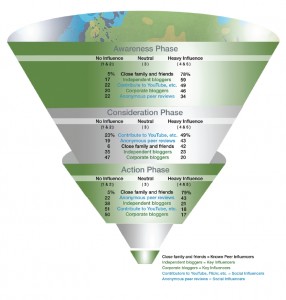The recent study by Razorfish on social media marketing entitled Fluent, has some great data about marketing in a social media context. The study clearly identifies your friends as crucial in the Awareness and Action phase, while the general Consideration phase people tend to rely on other sources for information:

Not much of a shocker of course, but good to see it in the context of the marketing funnel. However, the study fails to take into account an important behavioral aspect of social media. As research has proven several times, social media is really about hanging out with your friends in an online setting. Razorfish makes a somewhat of a big point of your “online friends” being less important than say TV ads, while your offline friends are the real key. Well, yes, but your “offline” friends are predominantly your “online” friends as well. I assume (although this can not be extracted from the report), that Razorfish’ definition of Online Friend excludes anyone you would categorize as a an Offline Friend. Based on what we know about online behavior at social networks, this “online friend” group becomes a really small and insignificant portion of anyone’s life anyway.
This statement is quite interesting: “[the consumer disbelief in the authenticity of online banner ads] underscores the
importance of ad units evolving to work with users’ behaviors in digital media, including social networks”. The decline in the effectiveness of banner ads has been known for a while, but this study puts it in the context of why consumers ignore them: they feel they are not authentic and simply not relevant. The recommendation from Razorfish is spot on, and this is the exact principle we have built our business on at Storyz (feel free to check out a pitch deck).
Razorfish introduces an interesting measure, the Social Influence Marketing score (SIM), which is basically a measure of the positive and negative conversations about your brand compared to the rest of the industry. This is indeed a very interesting measure, it does, however, ignore some aspects of brand interaction that does not necessarily have to do about talking about the brand, but engaging in activities in a branded context. For instance, if you are attending a Coca Cola music festival, you may not spend a second talking about Coca Cola, but afterwards you may be very positively inclined towards Coca Cola because you had a great music experience where their brand was everywhere. Still, the SIM score is an interesting measure, but as a standalone it is somewhat meaningless unless measured over time and compared to market share/financial performance. SIM could indeed be a leading indicator for financial performance in a balanced scorecard for a corporation, but it needs to be proven.
The Razorfish report contains a very good section on how to create social media ads, which is definitely worth a read. Towards the end, it can of drifts onto a number of articles, which is more like the stuff you will see every day on Mashable and other sites. For hard core data, their Feed report is still among the best.

Recent Comments